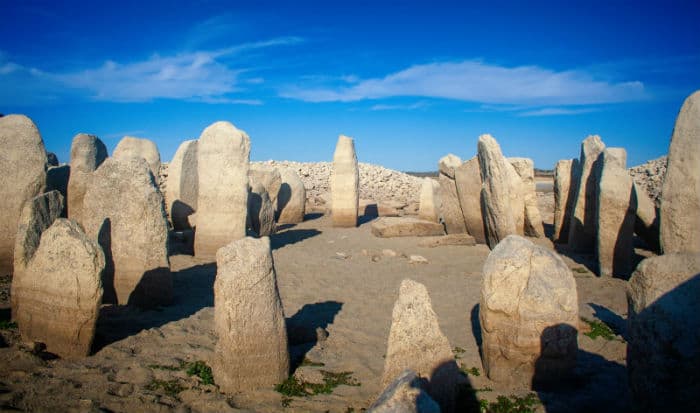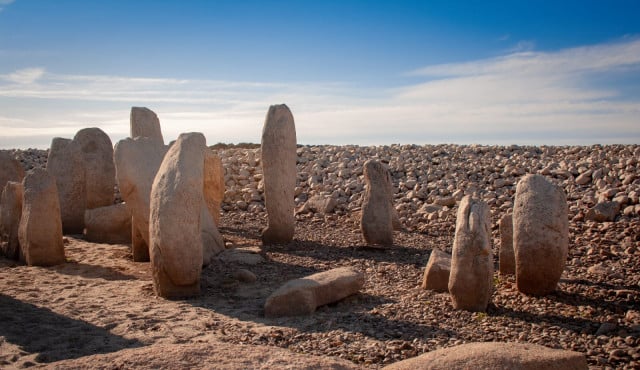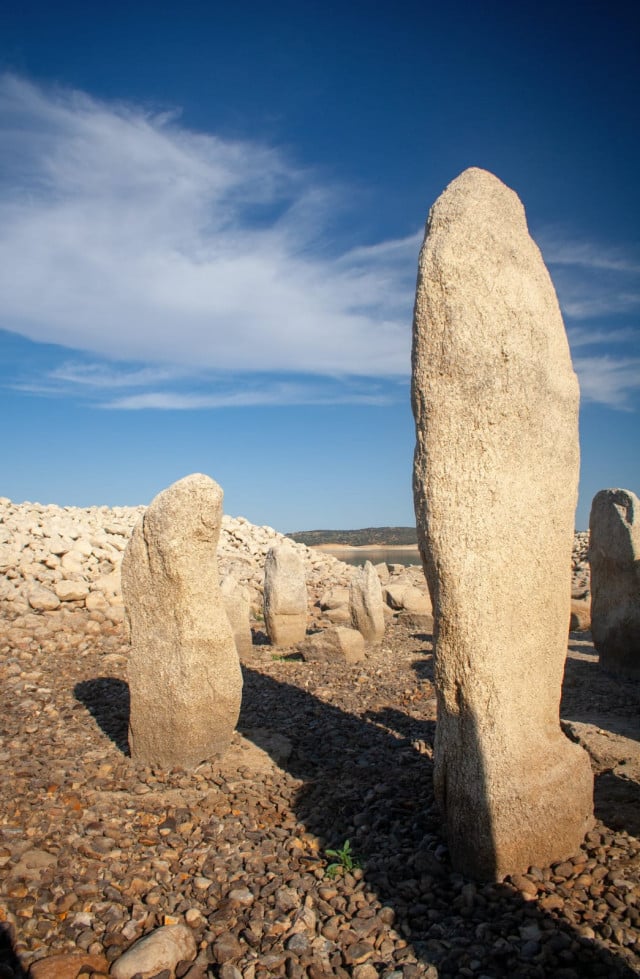Drought reveals long lost 'Spanish Stonehenge' in Extremadura reservoir

This year's drought may be a nightmare for farmers, but for archaeology buffs it has an unexpected silver lining.
As waters in a reservoir outside Peraleda de la Mata in Cáceres receded, a circle of megalithic standing stones emerged from the deep.
The stones, that date from the second and third millennium BC, form the site of a sun temple on the banks of the River Tagus and were last seen by locals six decades ago before the area was flooded during the Franco-era to create a reservoir.
Excited locals have been making trips out to view the stones that had formed a part of local legend.
“We grew up hearing about the legend of the treasure hidden beneath the lake and now we finally get to view them,” Angel Castaño told the Local.
“There certainly may have been treasures buried beneath the stones once upon a time, but for us now, the treasures are the stones themselves.”
Now, he is leading the race against time to preserve the site before the rains come.
The collection of 144 stones, some of which reach two metres high and have engravings of serpents, are arranged in circles, but like Stonehenge, it is unclear exactly who put them there and for what purpose.

“The site would have been created over thousands of years, using granite transported from kilometres away,” explained Castaño, who is part of the Raíces de Peralêda cultural association fighting to save the stones.
“Like Stonehenge, they formed a sun temple and burial ground. They seemed to have a religious but also economic purpose, being at one of the few points of the river where it was possible to cross, so it was a sort of trading hub.”
The stones began to emerge from the receding waters earlier this summer and now stand on dry land, for now.
“We have had no rain this summer, so the drought but also a policy of extracting water to send to Portugal has combined to lower the water table and reveal the stones. But that can all change very quickly.”
Castaño is leading a group of local residents campaigning to move the stones to a site on dry land before the waters rise again and they are lost.

“If we miss this chance it could be years before they are revealed again,” he explained. “And the stones, which are granite and therefore porous, are already showing signs of erosion and cracking, so if we don't act now it could be too late.”
He hopes that the regional government of Extremadura will step in to move the stones within weeks to a nearby site, that can then put the zone on the tourist map.
“There are already lots of reasons to come to this part of Spain but there is very little tourism,” Castaño said. “This could be the kick start that the region needs to bring tourism to the area.”

The Romans were the first to value the site which was then left neglected until Hugo Obermaier, a German priest and archaeologist enthusiast visited it in the 1920s.
He excavated the site and took whatever treasures could be moved back to Germany where they are displayed in a museum in Munich.
But the stones themselves were left in situ and disappeared beneath a reservoir when a dam was built in 1963.
“It isn't a difficult thing to move them, we have machinery now to do that,” said Castaño. “Let's just hope that there is the political will to save them while we can.”
A change.org petition is collecting signatures calling for the monument to be saved, if you want to lend your support CLICK HERE.
READ ALSO:
Comments
See Also
As waters in a reservoir outside Peraleda de la Mata in Cáceres receded, a circle of megalithic standing stones emerged from the deep.
The stones, that date from the second and third millennium BC, form the site of a sun temple on the banks of the River Tagus and were last seen by locals six decades ago before the area was flooded during the Franco-era to create a reservoir.
Excited locals have been making trips out to view the stones that had formed a part of local legend.
“We grew up hearing about the legend of the treasure hidden beneath the lake and now we finally get to view them,” Angel Castaño told the Local.
“There certainly may have been treasures buried beneath the stones once upon a time, but for us now, the treasures are the stones themselves.”
Now, he is leading the race against time to preserve the site before the rains come.
The collection of 144 stones, some of which reach two metres high and have engravings of serpents, are arranged in circles, but like Stonehenge, it is unclear exactly who put them there and for what purpose.

“The site would have been created over thousands of years, using granite transported from kilometres away,” explained Castaño, who is part of the Raíces de Peralêda cultural association fighting to save the stones.
“Like Stonehenge, they formed a sun temple and burial ground. They seemed to have a religious but also economic purpose, being at one of the few points of the river where it was possible to cross, so it was a sort of trading hub.”
The stones began to emerge from the receding waters earlier this summer and now stand on dry land, for now.
“We have had no rain this summer, so the drought but also a policy of extracting water to send to Portugal has combined to lower the water table and reveal the stones. But that can all change very quickly.”
Castaño is leading a group of local residents campaigning to move the stones to a site on dry land before the waters rise again and they are lost.

“If we miss this chance it could be years before they are revealed again,” he explained. “And the stones, which are granite and therefore porous, are already showing signs of erosion and cracking, so if we don't act now it could be too late.”
He hopes that the regional government of Extremadura will step in to move the stones within weeks to a nearby site, that can then put the zone on the tourist map.
“There are already lots of reasons to come to this part of Spain but there is very little tourism,” Castaño said. “This could be the kick start that the region needs to bring tourism to the area.”

The Romans were the first to value the site which was then left neglected until Hugo Obermaier, a German priest and archaeologist enthusiast visited it in the 1920s.
He excavated the site and took whatever treasures could be moved back to Germany where they are displayed in a museum in Munich.
But the stones themselves were left in situ and disappeared beneath a reservoir when a dam was built in 1963.
“It isn't a difficult thing to move them, we have machinery now to do that,” said Castaño. “Let's just hope that there is the political will to save them while we can.”
A change.org petition is collecting signatures calling for the monument to be saved, if you want to lend your support CLICK HERE.
READ ALSO:
Join the conversation in our comments section below. Share your own views and experience and if you have a question or suggestion for our journalists then email us at [email protected].
Please keep comments civil, constructive and on topic – and make sure to read our terms of use before getting involved.
Please log in here to leave a comment.